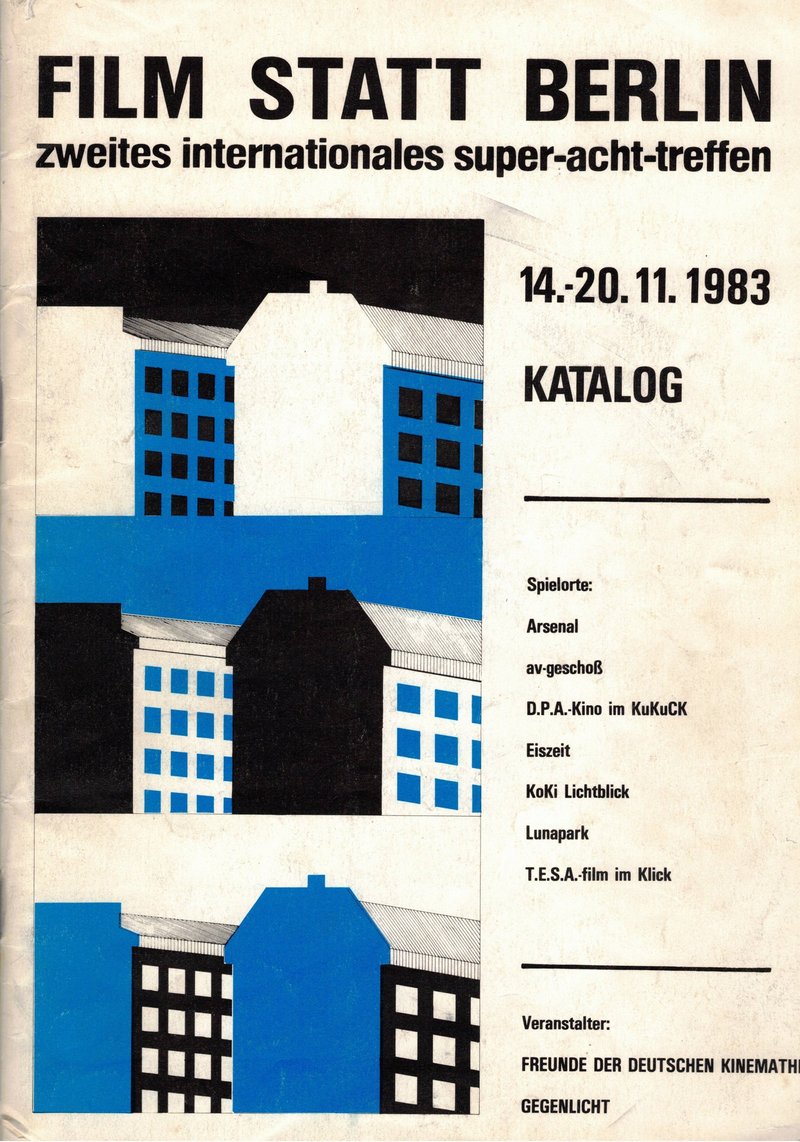
In 1983, the Arsenal cinema was added as a venue for interfilm 2. The organizers were the Friends of the German Cinematheque for one year.
Super 8 - this medium has always attracted attention in the programming work of the "Freunde der Deutschen Kinemathek".
Already in the seventies there were events with Berlin amateur film clubs or with groups that were strongly involved with S 8; like the coop "Das andere Kino". Super 8 films were shown in events like our "open house". Also in our preparatory work for the "International Forum of Young Cinema" we often came across super 8 films, which belonged to the center of what we are trying to promote and discover: to a free and independent cinema, which seeks new forms of expression and formulates experiences that do not find their way into other cinematic fields due to the production constraints and dependencies that exist there.
This included, for example, the beautiful and committed film about the Berlin Environmental Festival, WER KEINEN MUT ZUM TRÄUMEN HAT, HAT KEINE KRAFT ZUM KÄMPFEN (1979); or the brilliant self-ironic essay by the young Italian filmmaker Nanni Moretti, ICH BIN EIN AUTARKIST (1980).
Admittedly, these were still films that were blown up to 16 mm for wider distribution, and only in this form did they attract wider attention. Venezuelan Super 8 filmmakers, for example, consider the blowing up (even to 35 mm) essential in order to bring their films to the "real" cinema, as in the case of Diego Risquez and his film BOLIVAR, SINFONIA TROPIKAL (1980). Whether this advance of the S8 film into the "real" cinema realm is at all necessary and desirable, whether the work in the S8 format is, as it were, only a stopgap or a transitional stage on the way to the "real" cinema. a transitional stage on the way to professional film work - or whether the medium represents an independent area that justifies installing oneself in it "permanently" (and how continuity of work can then be ensured) - that is a question on which opinions differ; we hope to make a contribution to this discussion with the 2nd International S 8 Meeting.
Then again, we encountered "authentic" S8 films that also wanted to be screened in this format; like certain works by the uncompromising American experimental filmmaker Stan Brakhage (the cycle of his "Songs", still shot in normal 8!) or the works of the Frenchmen Gerard Courant, Teo Hernandez and Joseph Morder (we successfully screened his autobiographical film LE LAPIN A DEUX TETES / 1981 for the first time as part of the Forum also in the large Delphi cinema as a super 8 projection).
> At the same time, at the turn of the eighties, the super 8 film in Germany seemed to experience interesting new impulses - among other things as a counter-reaction to the German film landscape, which had become petrified and immobile due to its subsidy system. I still remember very well how, in 1982, at a discussion in Oberhausen on the 20th anniversary of the Oberhausen Manifesto, the super 8 filmmakers formulated a counter-position to the other filmmakers striving for subsidies and thus provided the only real counterpoint to the debate. Certainly, due to its low demand for production resources, Super 8 film can avail itself of much greater freedom than is available to "pro-professional" German film, which is subsidized and thus dependent on committees and television stations. This opportunity alone justifies paying special attention to the medium.
In addition, completely new audiences and modes of reception have been opened up for S8 films in recent years, some of which have little to do with traditional film situations, but perhaps represent the response of a new generation of filmmakers to conditions and dependencies with which one is not satisfied and which one would like to counter with something of one's own. Because we feel connected to these new developments in the field of film (to which super 8 nevertheless belongs), we are glad that with the 2nd International super 8 Film Meeting we have succeeded in establishing a connection between all the institutions that work in the super 8 field in this city, that all or almost all the important alternative venues are also "in on it", that we have put together a (as we hope) clear catalog and schedule of events, and that we have hopefully also made an optimal program selection. The representatives of the individual cinemas have selected from the films registered or sent in the films that seem to them to be the most useful for their own work or to represent the best quality. Hence the different programming of the individual cinemas.
Finally, we would like to thank the State of Berlin and the Senator for Cultural Affairs for the grant that made it possible to organize this meeting at all and also to invite some participants or programs from abroad. In order to make sure that the meeting does not only consist of reeling off films, we have included some seminar and discussion events in the program.
Last but not least, we would like to thank the "Gegenlicht-Verleih", who provided their experience in working with Super 8 and (together with their "friends") formed the organizational backbone of the event.
And now we wish the meeting a good course, the catalog a good sale and the event a frequent return.
Perhaps it can be an incentive and an enrichment for the Super 8 culture in this country and in this city; that super 8 culture, of which we wish that it preserves its autonomy and the freedom of its inspiration, but which can certainly stand to be put into a greater light of the public; not least, so that the ideas of what film can (also) be, are changed, expanded or questioned ... Ulrich Gregor